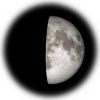All five of the planets that are visible to the unaided eye planets will be above the horizon at the same time, shortly before sunrise.
It is relatively rare for all of the planets to be aligned in one hemisphere so as to all be above the horizon at the same moment. Such an alignment between the five planets which are visible to the unaided eye happens roughly once every 6 years, while an alignment that also includes Uranus and Neptune, which require binoculars or a telescope to be seen, happens around once every 70 years.
However, since the planets in the outer solar system – especially Saturn, Uranus and Neptune – move quite slowly through the constellations, such alignments can occur multiple times in quick succession, or not at all for over 100 years.
The positions of all the planets at sunrise will be as follows:
| Planet | Altitude at sunrise |
Direction at sunrise |
Planet rises at |
Mag | Constellation |
| Mercury | 15.6° | south-east | 05:15 | -0.1 | Sagittarius |
| Venus | 18.7° | south-east | 04:52 | -4.0 | Sagittarius |
| Saturn | 32.6° | south | 02:54 | 0.3 | Ophiuchus |
| Mars | 39.7° | south | 00:37 | 0.7 | Libra |
| Jupiter | 25.6° | west | 20:26 | -2.4 | Leo |
Celestial coordinates
The positions of each of the planets will be:
| Object | Right Ascension | Declination | Constellation | Magnitude | Angular Size |
| Venus | 19h12m | 21°58'S | Sagittarius | -4.0 | 12"0 |
| Jupiter | 11h31m | 4°36'N | Leo | -2.4 | 42"1 |
| Mercury | 19h34m | 20°58'S | Sagittarius | -0.1 | 6"7 |
| Saturn | 16h52m | 20°51'S | Ophiuchus | 0.3 | 15"9 |
| Mars | 15h02m | 15°42'S | Libra | 0.7 | 7"1 |
The coordinates above are given in J2000.0.
Next/previous occurrences
| « Previous | Objects simultaneously visible | Next » |
| 22 Jan 1984 | All seven planets | 16 Jun 2022 |
| 30 Dec 2004 | All five planets that are visible to the unaided eye |
16 Aug 2016 |
The sky on 28 Nov 2025
| The sky on 28 November 2025 | ||||||||||||||||||||||||||||||||||
|
58% 8 days old |
All times shown in PST.
|
|||||||||||||||||||||||||||||||||
Source
The circumstances of this event were computed using the DE430 planetary ephemeris published by the Jet Propulsion Laboratory (JPL).
This event was automatically generated by searching the ephemeris for planetary alignments which are of interest to amateur astronomers, and the text above was generated based on an estimate of your location.
Related news
| 01 Feb 2016 | – Mercury at highest altitude in morning sky |
| 06 Feb 2016 | – Mercury at greatest elongation west |
| 18 Apr 2016 | – Mercury at highest altitude in evening sky |
| 18 Apr 2016 | – Mercury at greatest elongation east |
Image credit
The Moon in conjunction with Venus and Jupiter, with the Very Large Telescope in the foreground. Image © Y. Beletsky, ESO, 2009.


